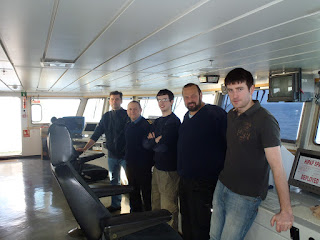We went out with a bang on the final
day of the survey, encountering a plethora of sea pens. What should
the collective noun for sea pens be? …Set? …Forest? ...Bed?
As we have been very lucky with the
weather, we made quick progress and had time left at the end of the
main survey programme to do some extra investigations in areas of
particular interest. We returned to the core area of Central Fladen site
to record some additional video footage around the stations where the
tall sea pen Funiculina quadrangularis had been found, in
order to better estimate its distribution. The night shift struck
gold at one station where a high density of tall sea pens was
recorded, and they took some fantastic pictures. Tall sea pens were
also found at a number of other stations either side of the area they
had been identified earlier in the survey. It appears that they are
distributed in a thin band along the Central Fladen site in
association with slightly coarser sediment, following the contours of
the bathymetry. Stations placed either side of this thin band did not reveal any further tall sea pens.
 |
| Brittlestar entwined around a Funiculina seapen |
 |
| Spider crab (Lithodes maja) |
During the day, we also returned to an
area to the north-west of the Central Fladen site where multibeam bathymetry revealed a large trench reaching down to over 300m. There was a
strong backscatter return at the bottom of this trench which
indicated a coarser sediment. We collected video footage and a grab at
two locations along this trench in order to groundtruth the
bathymetry data and capture any variation in sediment and associated
fauna as depth increased. The drop-camera was used as the camera sledge may have
run into difficulties being towed down such a step decline.
Scientists gathered round to see what the depths would reveal,
including a few bleary-eyed members of the night shift who had stayed
up especially. The video footage confirmed predictions regarding
sediment, showing muddy sand with shells going down and an increasing proportion of cobbles and boulders. A grab was taken at the foot of the slope
using the Hamon grab, as this is more effective than the Day grab at
sampling coarser sediments. The grab retained sediment with a high
proportion of gravel and fewer infauna species.
So that brought the Fladen grounds
survey to a close, and we bid farewell to the Scottish seas and began
our steam back to Lowestoft. We’ve had an enjoyable and productive
survey all in all, successfully confirming the presence of the tall
seapen and verifying the burrowed mud habitat predicted in UKSeaMap
through ground truthing. Many thanks to the crew of the Endeavour and
the Cefas team for a great trip.
 |
| Day shift scientists |
 |
| Night shift scientists |
 |
| Bridge crew |
 |
| Deck crew |
Signing off (with a sea pen, obviously)




